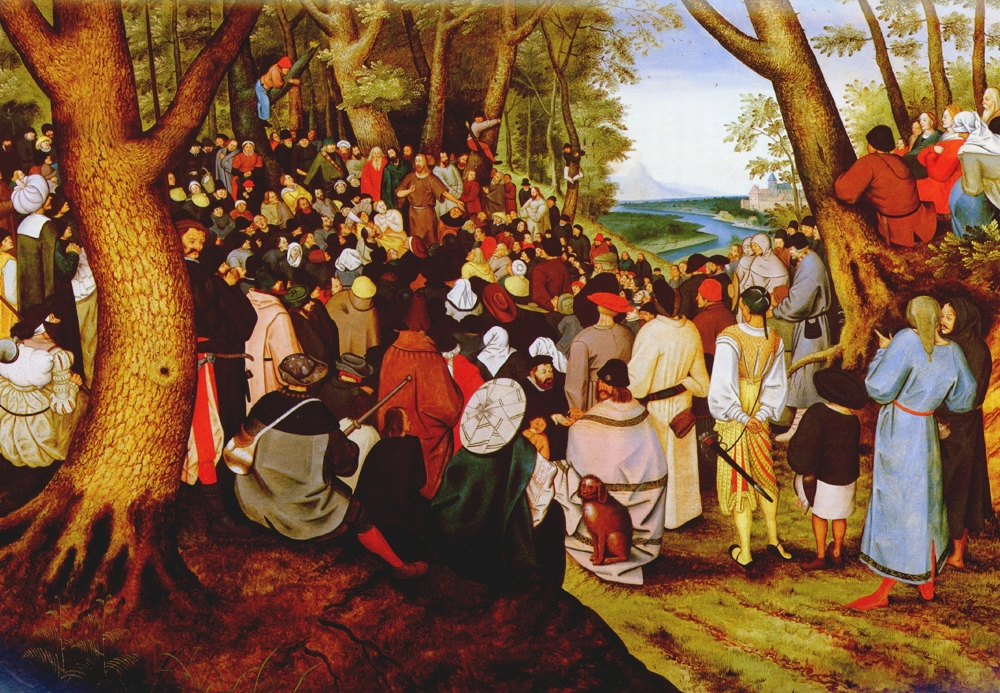
Landscape with St. John the Baptist preaching by Pieter Brueghel the Younger at Rheinisches Landesmuseum, Bonn, Germany (Wikimedia Commons/Art Renewal Center)
Some years ago, artist St. Joseph Sr. Marian Cowan created a small sculpture of the Visitation. It depicts two pregnant women seated, bending toward one another, knee to knee, engrossed in each other's gaze. Animated hand gestures hint at their lively conversation. Looking on in silence, a man in a tunic and yarmulke bends into the circle. Keeping his hands gently clasped behind him, he listens.
In what appears to be a variation on icons of the Trinity, this depicts Mary, Elizabeth and Zechariah at the time of Mary's visit to the senior couple. The two women, one elderly and one very young, represent the sacred fertility of their times. Zachariah silently contemplates the mystery of new life, wondrous beyond his understanding. The three rejoice together as they trust in God's incomprehensible loving plans.
Luke's portrayal of the birth of John the Baptist picks up just after the time depicted by this sculpture. In today's Gospel, Mary has returned home and Elizabeth has given birth to the last of the ancient prophets and forerunner of the Messiah.
John is a most unusual saint. A fiery preacher who was unafraid to call soldiers and tax collectors to reform, his ministry came to an end because he spoke the truth about King Herod, the conniving, cowardly womanizer who exercised far more power than strength or conscience.
Luke's account of John's birth sets the stage for the novelty of the Gospel. Having read the whole story in Chapter 1 of Luke, we know that John came from an exceptional family. It wasn't just that his parents were too old to have children, but his father, a priest, had been miraculously mute since the day an angel announced that John would be born.
Elizabeth, his mother, herself from a priestly clan, became the spokesperson for the family. She not only named their child, but when she acknowledged Mary as the mother of the Lord, she and the child who leapt in her womb became the first to proclaim Jesus.
Zachariah and Elizabeth, the new Abraham and Sarah, a silent priest and woman prophet, are signs that God's faithfulness is fresh every day.
How did this beginning form John the Baptizer into the prophet he would become? Knowing the circumstances of his birth, people said, "Surely the hand of the Lord was with him" (Luke 1:66). More like his mother than his father, John avoided Jerusalem and the centers of power, remaining far from the public eye until he began his preaching career. But when he began, he did it with his whole heart and impeccable integrity. No threat had the power to stop him: He was God's sharp sword and polished arrow.
In a time of mystifying change, John showed the humility and faithfulness to be the precursor who never knew precisely who was to come after him. He began his mission in an in-between time while Jesus was living in obscurity. He baptized Jesus — hesitantly, according to Matthew. John the Evangelist even tells us that the Baptizer saw God's Spirit descend on Jesus and called him the Lamb of God.

(Mark Bartholomew)
Nevertheless, John never became Jesus' disciple. For whatever reason, the Spirit did not bestow that gift of faith on him.
John is one of a few figures from the Christian Scriptures whom we call saints even though they were not followers of Jesus. He called his people to prepare their lives and hearts for what was to come, but he couldn't proclaim a mystery that was yet to be revealed. Living a vocation that seemingly required more faith than Jesus ever asked of his disciples, John's most powerful preaching was and still is the example of his life. Authentic to the core, John remained passionately dedicated to his mission.
Like the faithful prophet described in Isaiah's Servant Song, though he may have thought he had toiled in vain, John placed his trust in the God who called him rather than in his own vision or understanding. John was the ideal precursor, faithful enough to withstand the tension of the in-between time that bridged past and future.
John may be just the saint we need for our times. While we know the Christ he could only hope for, we too live an in-between time. Many aspects of the modern world to which we have been accustomed are changing or ending. The most we know about the future is that we cannot imagine it.
John the Baptizer was formed by his father, the priest who had to keep silence, and his mother, the woman who prophesied. Who better than John to teach us how to cultivate hope and help others trust in God's unpredictable, unlimited faithfulness
Advertisement
[Mary M. McGlone is a Sister of St. Joseph of Carondelet who is writing the history of the Sisters of St. Joseph in the U.S.]
Editor's note: This Sunday scripture commentary appears in full in NCR's sister publication Celebration, a worship and homiletic resource. Request a sample issue at CelebrationPublications.org. Sign up to receive email newsletters every time Spiritual Reflections is posted.








